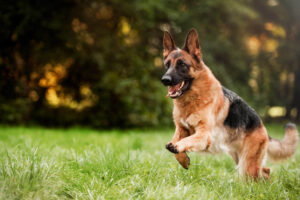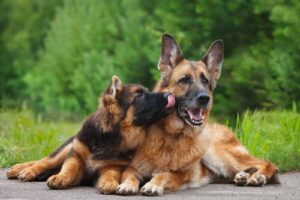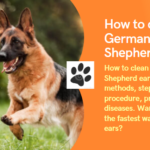The female German Shepherd, like other female dogs, has regular reproductive cycles, called the heat cycles. During this time, the female dog can mate with a male dog to give birth to puppies.
How long is a german shepherd in heat?
If your pet is a female German Shepherd, you should be ready for the German Shepherd’s first heat. Therefore, it is important to know what is heat, when the shepherds go into heat, what are the signs of heat and how to find out that your shepherd is in heat.
Let’s discover together everything you need to know about a German Shepherd’s heat cycle.
What is heat?
Heat is when a female dog reaches sexual maturity like a teenager. Some people compare a dog’s heat cycle to a human’s menstrual cycle, but these are completely different things. Unlike humans, bloody discharge in female dogs doesn’t mark the end of a cycle, it indicates the onset of the fertile phase.
Heat is an entirely natural process in the female dog’s life, normal for every healthy female dog. Heat occurs twice a year: each time for about three weeks, your female GSD will feel the need to mate and, therefore, reproduce.
It is also important to note that menopause does not exist in dogs, heat cycles continue throughout the dog’s life, so your female GSD will be able to reproduce from sexual maturity to death; even a very old female dog can give birth.
When is a German Shepherd’s First Heat?
First heat can happen anytime between 6 months to almost two years. The age at which the first heat occurs depends on the breed (if it’s a large breed or small breed), or especially on the weight of your dog.
In large breeds of dogs, such as the standard German Shepherd, first cycles usually occur between 9-12 months of the dog’s life. So the heat will last approximately three weeks.
Dog lovers should know that it is better to wait two and a half or even three years before your dog can mate. The first heat can be very imperceptible so it can pass completely unnoticed by the dog owner.
Let’s talk about some signs and things that you can notice when your dog is coming into heat.
How do you know if your dog is in heat?
In most dogs, signs of the heat cycle are easily visible. Other dogs are much more subtle, and their owners can completely miss all the signs.
- A swollen vulva.
Their vulva, the area where the pee comes out, it gets swollen, it’s getting a little bigger, a little redder, a little puffier, and then you’ll notice some bloody discharge coming up so that’s the main sign that your dog definitely is in heat. A swollen vulva is the initial sign of heat in dogs, and many owners notice this only if they are specifically looking for it. This can be especially difficult to notice with a moderately long German Shepherd coat.
- Vaginal discharge.
Although it usually occurs one to three days after the start of your dog’s heat cycle, this may be the first symptom you notice. Discharges usually contain blood, although the amount varies. It can be light or dark brown and usually changes over the course of the cycle.
- Licking genitals and surrounding areas.
Your dog can be excessively licking himself to stay clean.
- Mood swings.
If your dog is in heat, her hormone levels rise and can change her behavior. Most dogs become more anxious and, as a result, more needy than normal. Most dogs become more anxious and, as a result, more needy than normal. They also become more cuddly wanting to cuddle, kiss, be hugged, and really clingy to dog owners. However be careful, because some dogs can become slightly irritable.
- Frequent urination
You can notice that when you take your dog out walking she peed a lot, not once or twice a walk, it’s like three, four, five even six times every couple minutes, so she’s almost becoming like a male dog wanting to pee. During the heat cycle, this means that your dog instinctively needs to make his condition known by pheromones in her urine. Dog owners often confuse frequent urination with signs of urinary tract infection.
- Special attention to male dogs.
Male dogs can spot female dogs in heat from miles away and can be extremely persistent in trying to meet them.

How long is a german shepherd in heat?
How long does a German Shepherd’s heat cycle last?
In most breeds, the heat lasts an average of 3 weeks, with possible individual variation, and these estruses occur twice a year with an average interval of 6 months between each heat cycle. In female German Shepherds, the heat cycle is a normal process every 4.5-5 months.
The interval between two heat cycles periods can be more or less long, depending on:
- climate or season: the dog is able to breed all year round, but the climate can affect the onset of the heat cycle.
- taking certain medications: some medications can disrupt the rhythm of the cycle or even completely stop it.
- the presence of other female dogs: when several female dogs live together, two things can happen: their heat cycles can synchronize or some female dogs can stop having heat.
Remember, however, that it is the regularity of the rest phase between two periods of heat that is more important for the dog than the rhythm in which your dog should go into heat.
If a dog that had regular heat starts to have heat more and more distant or conversely, closer, it is advisable to consult with a veterinarian, without waiting too long. This change in rhythm may reflect an ovarian problem or a dysendocrine condition.
Four stages of a heating season
The heating season in dogs is not only the period when she has bloodу discharge. Bloody discharge is not an entire cycle, only part of the German shepherd’s heat cycle starting with the proestrus stage and ending with the anestrus stage. The full cycle includes four stages.
Let’s look at each of these different stages in detail to better understand what happens to your German Shepherd and other dogs in heat.
Proestrus Stage
The first stage is called the proestrus stage, it usually lasts about nine days (sometimes up to twenty days). During the first stage, the dog’s vulva increases in volume and vaginal discharge appears, estrogen levels rise, and progesterone levels are almost zero.
The female dog secretes sexual pheromones with urine and vaginal discharge, which are perceived by male dogs and attract them. However, most female German Shepherds still refuse to mate at the proestrus stage. The first-week male dog will sniff or lick a female’s bum but is not interested in breeding her.
Estrus Stage
The second stage is the estrus stage or estrus. This is the main stage in a German Shepherd’s heat cycle. During the second stage (estrus stage) of the heat cycle, ovulation occurs, and the fertile window is open. You can notice common signs of a dog in heat: the vulva becomes even more swollen and bloody discharge decreases and becomes lighter or sometimes stops completely.
It is at this period that the female dog can be fertilized by a male dog and she’s ready to mate. Male dogs begin to react to the smell of the German shepherd in heat.
The Estrus cycle lasts from a week to 10 days, but the first three to 5 days are the most fertile phase. At this time, there is a decrease in estrogen and an increase in pro-estrogen.
Diestrus Stage
The third stage is the diestrus stage, also called the metestrus stage. It’s a rest period for female German Shepherds or other dogs. This period after the estrus stage marks the end of the breeding period for your dog. The vulvar swelling and vaginal discharge subside, your dog returns to her normal state and her progesterone level reaches a peak. It can last up to 80 days.
Anestrus Stage
German Shepherd heat cycle ends with the fourth stage, which is the anestrus stage. This is the longest stage of the heat cycle, which lasts about three or four months.
Let’s talk about estrogen levels and other heat signs. Everything returns to normal: estrogens and progesterones are secreted in small quantities, there are no vaginal bleeding and normal-sized vulva, and reproductive organs are resting. That is why anestrus is characterized as a stage of sexual rest.
Despite the fact that the female German Shepherd has no visible physical signs of heat and hormonal changes, the fourth stage is also an important part of the heat cycle, because this is the period when the female GSD can rest, and her body has time to prepare for the next heat cycle.
Things you will need when your Shepherd is in heat.
So, now we’re going to go on to talk about some of the things that you’re going to need when your female GSD is in heat.
You will need hygienic protection for your dog so that she does not stain your house when she has bloody discharge. There are dog pants or underwear, these pants have a spot for a tail. You will also need pads or sanitary liners that need to be changed regularly to avoid infections.
These dog pants mostly are used to keep your house clean, it’s not protected to prevent her from dog breeding and accidental pregnancy, this is just to keep your house clean, that’s all.

Things your German Shepherd can’t do while she’s in heat
So now we’re going to talk about things your female GSD can’t do when she’s in heat.
Your German Shepherd can’t be around any male dogs unless you’re wanting to breed her, so you need to take some precautions to avoid accidental pregnancy of your pet.
Be more attentive while walking with your Shepherd in heat, because her behavior towards male dogs will change. An unsterilized dog in heat attracts male dogs at a distance, so there are no off-leash walks or unleashed walks. Even if your dog is obedient, it can ignore your orders when a male dog appears, because this is an absolutely natural process in the heating season for a dog.

If you are walking your female German shepherd in the yard or in the garden, you have to make sure that your yard is secure and then there are no spots where she can get out or another male dog could get in to avoid accidental mating.
What to do after your dog’s first heat
After your German Shepherd runs out of her first heat cycle, you need to make a decision about whether you are going to breed your dog or sterilize it.
It is better to sterilize German Shepherds that are not intended for reproduction. In this case, female dogs do not feel the need to become a mother and therefore do not feel any inconvenience. Sterilization is not only a way to avoid the inconveniences associated with the German shepherd heat cycle, but it is also a good solution to preserve the health of your female GSD.

You should also know that the later the sterilization of German Shepherds is carried out, the fewer positive consequences it will have. Moreover, during estrus cycles, female GSDs are more and more at risk of tumors and infections. Therefore, it is better to sterilize German Shepherd dogs before their first heat cycle or, at the latest, after the first heat or after the first pregnancy. Thus, the German Shepherd will gain several years in terms of life expectancy. Almost every dog lover who does not plan to breed his German Shepherd sterilizes his pet.
Talk to your veterinarian if you are hesitant to sterilize your German Shepherd. He will be able to advise you about the risks to which the dog is exposed and inform you about the advantages and disadvantages of such surgical intervention.
Is it bad for German Shepherds to go into heat?
Heat cycles without reproduction, and hormones in female German shepherd dogs, as a rule, cause complications with age. The same applies to the use of canine contraception, as it also works on the basis of hormones. Therefore, the risk to a German Shepherd’s health is significant, especially with the development of breast tumors, the occurrence of nervous pregnancies, or even various uterine and vaginal infections.
Although heat cycles are a normal process for dogs, you can feel that your female GSD is suffering from some distress. If you are not planning to breed your German Shepherd, there are several good reasons why she should not go into heat.
Pyometra is an infection in which the uterus is filled with pus. You can eliminate the risk of developing pyometra in your female GSD by surgically removing her uterus and ovaries.
Breast tumor – sterilizing your dog before its first heat cycle reduces the risk of developing breast cancer. Even if you sterilize your German Shepherd before the second heat cycle, you can significantly reduce its risks.
Conclusion
So, key points to remember for dog owners, especially owners of German Shepherds:
1. The first heat means that your dog is now sexually mature and she’s ready for breeding.
2. In dogs of large breeds, such as German Shepherds, this period occurs between 9 and 12 months.
3. Like most large dogs, German Shepherds go into heat twice a year and it lasts on average about 3 weeks. It is worth noting that the regularity of cycles is more important than their frequency.
4. A female German Shepherd always ovulates during estrus. It is during this period that the fertile window opens, and she can become pregnant.
5. The German Shepherd attracts males with its smell during estrus at a distance, so make sure they can’t get close to her to avoid accidental mating.
6. The estrus period is accompanied by hormonal changes, physical signs, and changes in the behavior of your German Shepherd (and other dogs next to yours)
7. During estrus, some German Shepherds can ignore your orders.
8. If your dog behaves aggressively or she’s agitated during estrus, try to calm her down by playing with her or doing things familiar to her.
9. Use hygienic protection for your dog so that she does not stain your house like dog pants or underwear, pads, or sanitary liners. To get her used to them, you can train her before the estrus stage begins.
10. If you do not want your dog to reproduce, it is better to sterilize it, because this eliminates the risk of developing pyometra, a serious infection of the uterus, and the appearance of a breast tumor.
Now you know how to determine your German Shepherd in the heat cycle, when it can occur, and, above all, how to act accordingly. Be patient with her at this time. It’s normal that his behavior can be difficult during estrus. And if you can’t cope with these periods, remember that sterilization is possible.
Don’t forget to share this article with dog lovers. We also receive compensation for the referring traffic, which allows us to create similar content for you.
Contact form


